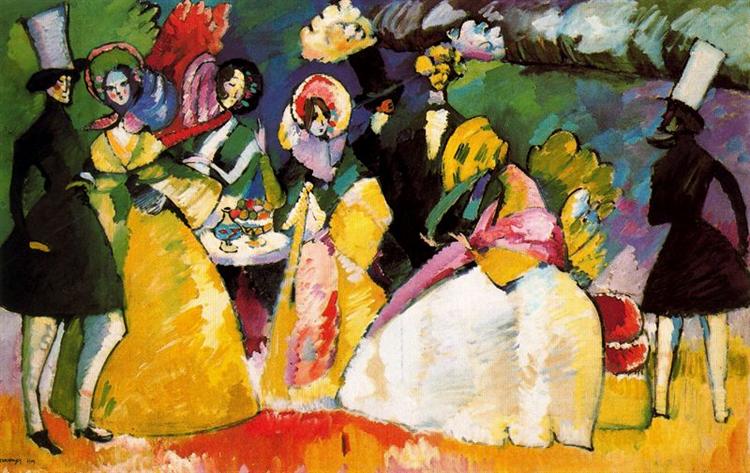Description
The painting "Group in Crinolines" of Wassily Kandinsky, created in 1909, is located in a crucial period of the evolution of modern art, where the use of color and shape begins to challenge traditional conventions. In this work, Kandinsky shows not only his interest in the representation of the human figure, but also his search for a new visual language that transcends mere mimesis.
At first glance, what impacts "Crinolin Group" is the lush vibrant color palette. Green, yellow and roses tones combine almost synergisticly, creating an atmosphere of vivacity and energy. This expressive use of color is characteristic of Kandinsky and reflects its belief in the ability of art to evoke emotions and moods. Colors are not mere representations of reality, but vehicles for spiritual and emotional expression.
The composition of the work is organized around the figure of a group of women, whose clothing highlights the use of crinolines, a fashion symbol at the time that symbolizes both femininity and a certain opulence. These figures, although stylized, evoke the essence of the social portrait of the time. The ways in which the drape of the dresses has worked has an obvious plastic nature, creating a visual movement that guides the viewer's gaze. The figures seem to emerge to life through the dynamic use of lines and contours, which interact and interact, suggesting a connection not only between themselves, but with the surrounding environment.
Throughout his career, Kandinsky was interested in the symbolism of the form, and in this work, human figures are represented semi-abstrakta, moving away from the strict realistic representation. This gives rise to deeper interpretations about the role of women in society that was created at the beginning of the 20th century. While it cannot be affirmed that the work is openly political, a reflection on female identity in a constantly changing social context insinuates.
The historical context of "Crinolin Group" is also essential to understand the evolution of Kandinsky's style. During this period, the artist experimented with symbolism and Fauvism, looking towards the essence of colors and their relationship with shapes. Although many of his subsequent works would be inclined more towards pure abstraction, "Crinolin Group" represents a bridge between figurative representation and abstract language that would later dominate its production.
It is important to mention that Kandinsky's work had a significant influence on the development of expressionism, a movement that valued subjective expression on objective representation. "Crinoline group" can be contemplated not only as a representation of emerging modernity, but also as an exploration of human experience through a vibrant and emotional lens.
In conclusion, "Crinolines" of Wassily Kandinsky is a work that encapsulates the transition between figurative and the abstract, offering the viewer a look at the complexity of identity in the context of social changes. Through his distinctive style and innovative use of color and shape, Kandinsky not only challenges the artistic conventions of his time, but also leaves an indelible mark on the way to abstraction in modern art.
KUADROS ©, a famous paint on your wall.
Reproductions of paintings handmade oil, with the quality of professional artists and the distinctive seal of KUADROS ©.
Art reproduction service with satisfaction guarantee. If you are not completely satisfied with the replica of your painting, we refund your money 100%.

